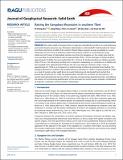Files in this item
Raising the Gangdese Mountains in southern Tibet
Item metadata
| dc.contributor.author | Zhu, Di-Cheng | |
| dc.contributor.author | Wang, Qing | |
| dc.contributor.author | Cawood, Peter A. | |
| dc.contributor.author | Zhao, Zhi-Dan | |
| dc.contributor.author | Mo, Xuan-Xue | |
| dc.date.accessioned | 2017-07-21T23:34:13Z | |
| dc.date.available | 2017-07-21T23:34:13Z | |
| dc.date.issued | 2017-01 | |
| dc.identifier | 248656970 | |
| dc.identifier | b88bd4e3-f2ae-4db1-8b82-873db9dfbee8 | |
| dc.identifier | 85013231166 | |
| dc.identifier | 000395658900012 | |
| dc.identifier.citation | Zhu , D-C , Wang , Q , Cawood , P A , Zhao , Z-D & Mo , X-X 2017 , ' Raising the Gangdese Mountains in southern Tibet ' , Journal of Geophysical Research: Solid Earth , vol. 122 , no. 1 , pp. 214-223 . https://doi.org/10.1002/2016JB013508 | en |
| dc.identifier.issn | 2169-9356 | |
| dc.identifier.other | Bibtex: urn:a8875dc16e7876f6276c218710df014d | |
| dc.identifier.uri | https://hdl.handle.net/10023/11262 | |
| dc.description | This research was financially supported by the MOST of China (No. 2016YFC0600304 and No. 2016YFC0600407), the Strategic Priority Research Program (B) of the Chinese Academy of Sciences (XDB03010301), the National Science Foundation of China (41225006 and 41472061), and the MOST Special Fund from the State Key Laboratory of Geological Processes and Mineral Resources (China University of Geosciences). | en |
| dc.description.abstract | The surface uplift of mountain belts is in large part controlled by the effects of crustal thickening and mantle dynamic processes (e.g., lithospheric delamination or slab breakoff). Understanding the history and driving mechanism of uplift of the southern Tibetan Plateau requires accurate knowledge on crustal thickening over time. Here we determine spatial and temporal variations in crustal thickness using whole-rock La/Yb ratios of intermediate intrusive rocks from the Gangdese arc. Our results show that the crust was likely of normal thickness prior to ca. 70 Ma (~37 km) but began to thicken locally at ca. 70 − 60 Ma. The crust reached (58 − 50) ± 10 km at 55 − 45 Ma extending over 400 km along the strike of the arc. This thickening was likely due to magmatic underplating as a consequence of rollback and then breakoff of the subducting Neo-Tethyan slab. The crust attained a thickness of 68 ± 12 km at ca. 20 − 10 Ma, as a consequence of underthrusting of India and associated thrust faulting. The Gangdese Mountains in southern Tibet broadly attained an elevation of >4000 m at ca. 55 − 45 Ma as a result of isostatic surface uplift driven by crustal thickening and slab breakoff, and reached their present-day elevation by 20 − 10 Ma. Our paleoelevation estimates are consistent not only with the C − O isotope-based paleoaltimetry but also with the carbonate clumped isotope paleothermometer, exemplifying the promise of reconstructing paleoelevation in time and space for ancient orogens through a combination of magmatic composition and Airy isostatic compensation. | |
| dc.format.extent | 1508710 | |
| dc.language.iso | eng | |
| dc.relation.ispartof | Journal of Geophysical Research: Solid Earth | en |
| dc.subject | Crustal thickness | en |
| dc.subject | Gangdese Batholith | en |
| dc.subject | Paleoelevation | en |
| dc.subject | Driving mechanism of uplift | en |
| dc.subject | Southern Tibet | en |
| dc.subject | GE Environmental Sciences | en |
| dc.subject | NDAS | en |
| dc.subject.lcc | GE | en |
| dc.title | Raising the Gangdese Mountains in southern Tibet | en |
| dc.type | Journal article | en |
| dc.contributor.institution | University of St Andrews. Earth and Environmental Sciences | en |
| dc.contributor.institution | University of St Andrews. School of Geography and Geosciences | en |
| dc.contributor.institution | University of St Andrews. Scottish Oceans Institute | en |
| dc.contributor.institution | University of St Andrews. St Andrews Isotope Geochemistry | en |
| dc.identifier.doi | 10.1002/2016JB013508 | |
| dc.description.status | Peer reviewed | en |
| dc.date.embargoedUntil | 2017-07-21 |
This item appears in the following Collection(s)
Items in the St Andrews Research Repository are protected by copyright, with all rights reserved, unless otherwise indicated.

